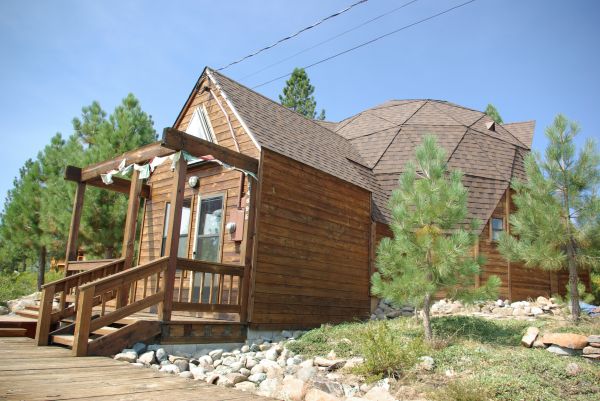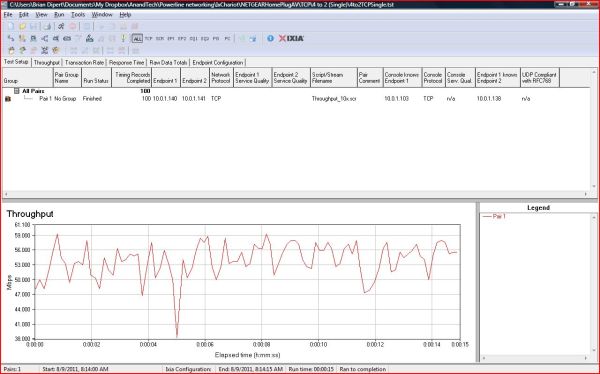Hands-On Powerline Networking: How Well (Or Not) Are Latest-Generation Devices Working?
by Brian Dipert on September 1, 2011 12:41 AM EST- Posted in
- Networking
- Powerline Adapters
- NetGear
My approximately 1300-square-foot geodesic-dome residence dating from the mid-1980s serves as my test bed.
Three of the powerline-network nodes I tested were in the approximately 25-foot-diameter downstairs main room:
- Against one wall in a dining-room nook (node 1)
- In the middle of the room on a stairwell near the entertainment system, (node 2)
- Against the opposing wall near the router (a 'fall 2007' Apple Airport Extreme N, model MB053LL/A, with GbE LAN ports).
Next door to the router is the "mud room", containing the fourth power outlet I employed in the testing (node 4), as well as the circuit-breaker box. I used another entertainment system in the upstairs bedroom as the fifth power-line node (node 3). Each AC outlet connects to a phase of the premises' 220V power feed, but I didn’t know (and intentionally didn't try to figure out, thereby mimicking a typical consumer's approach) which phase or which circuit breaker each network node employed.
Per the discussion in the prior section of this writeup, I employed various measures to minimize the effect of attenuation for these tests. I ensured that surge protectors and UPSs weren't between any of the power-line adapters and their associated power outlets. As a long-time powerline networking veteran, I have noise filters permanently installed between the power grid and both my refrigerator’s compressor and my home’s furnace fan; neither the refrigerator, furnace nor any other motors were operating when I was logging benchmark results. I also kept fluorescent bulbs extinguished, and I unplugged all of my AC adapters, battery chargers, and other wall-wart-based and otherwise AC-to-DC-fueled devices.
With respect to benchmarking utilities, AnandTech's Brian Klug leveraged iPerf (an open-source package I've also extensively used in the past) for his recent testing of Apple's latest generation Airport Extreme router and Time Machine. And Jarred Walton harnessed a suite of software in his more recent evaluation of Bigfoot’s Killer-N 1102 Wireless Half-Mini PCIe 1.1 add-in module. In my particular case, I went with another program I'd used before, Ixia's IxChariot. IxChariot’s Console utility, a Microsoft Windows application, sets up, manages, and periodically collects data from various tests.
The companion network-node-resident utility, Ixia’s Endpoint, runs on Linux, Mac OS X, and Windows OSes. Console comes with more than 100 company-created scripts, and users can also customize them and create brand-new scripts. Because Console also bundles Endpoint, you can theoretically run Console from the same machine that acts as one of the tested network nodes. However, as I'd learned in the past, such a setup is not optimal for accurate testing. Using the same system CPU resources for both Console and Endpoint means that you may be unable to run either of them at full speed. Console and Endpoint functions also contend for limited networking-transceiver bandwidth.
Alternatively, as I did in these particular tests, you can run Endpoint software on two systems, with the Console utility executing on a third computer that communicates with the other two. In that case, the Console-installed PC can also have lower network performance than the others. According to Michael Githens, lab-programming manager at Ixia, “It doesn’t need a high-speed connection, [as the test links do]. It is passing less data; the results come only from the test links, not the management links.” And in fact, the Console communication with each Endpoint in my particular setup occurs over Wi-Fi, so as to not impede the Endpoint-to-Endpoint traffic flow over the power grid (which would therefore under-report the performance potential of any particular powerline networking span).
However, I chose to disregard one other Ixia setup recommendation offered by Intellon-then-Atheros-now-Qualcomm, who sells the silicon inside two of the three powerline adapters tested in this study. Qualcomm suggested that I give the Endpoint systems' wired Ethernet transceivers (therefore the powerline adapters connected to them) static IP assignments, thereby enabling them to directly communicate with each other with no periodic router overhead. While Qualcomm's proposal is likely accurate in its prediction, it doesn't match the DHCP-assigned way that the bulk of LAN clients in both corporate and consumer settings obtain their IP addresses. As such, I left the Endpoints at their DHCP-configured defaults, thereby explaining the fifth powerline adapter in my topology, connected to the router for DHCP assignments (and renewals) and other like functions.
My Console-running system is a Dell XPS-M1330 laptop, based on Windows Vista Ultimate. As previously mentioned, it interacts with the two Endpoints over 802.11n Wi-Fi connections. The Endpoint systems are both Macs, a first-generation May 2006 13" MacBook running Mac OS 10.5 Leopard and an April 2010 13" MacBook Pro based on Mac OS 10.6 Snow Leopard. Both of the latter two systems contain GbE transceivers, a critical requirement for matching up with the GbE ports in the '500 Mpbs' IEEE 1901 powerline adapters I evaluated.












53 Comments
View All Comments
quiksilvr - Thursday, September 1, 2011 - link
Have you tried getting a better router and/or perhaps a better wireless card for your laptop?akedia - Thursday, September 1, 2011 - link
I have a current generation Airport Extreme, which is generally regarded as one of the best wireless routers available, and the built-in WiFi antenna in my Mac mini is not upgradable, as far as I know. My roommate's laptop is an HP dm1z, also not upgradable, and my Droid X is stuck with the antenna it shipped with as well. It's not my hardware, it's my environment. WiFi has limitations, like it or not.bdipert - Thursday, September 1, 2011 - link
Different tools for different tasks, jigglywiggly. Powerline can make a pretty good 'backbone' technology if, as I state in the article, you want to 'dispense with burrowing through dirty, spider- and snake-infested crawlspaces and drilling holes in walls and floors in order to route Cat5e cable around'. Wi-Fi conversely can be effective across intra-room and few-room spans...and with mobile devices.Paedric - Thursday, September 1, 2011 - link
Thanks for the article first, that's something I've been interested in for quite some time.However, I have a question; you tested it in a "perfect" environment by disabling interfering devices, to test the potential of the system, but what happen if it is not the case?
Is the performance hit really noticeable?
I don't want to rout a cable across the whole house, but I'm not really keen on turning off the fridge, lights, and unplugging devices every time I want to connect to the internet.
Denithor - Thursday, September 1, 2011 - link
I have the TRENDnet TPL-303E2K Powerline AV Adapter Kit installed in my home, connecting my wireless router in the living room to my office computer about 50 or 60 feet away. Couldn't get a solid enough wireless signal in the office for any kind of gaming, hooked up this kit and within literally 2 minutes was playing everything just fine.There's no need to unplug or turn off anything. It just works...
gariig - Thursday, September 1, 2011 - link
I bought my parents the same TRENDnet that Denithor has (crazy coincidence) because their wireless router and extra computer are on the other side of a ~2000 SQ FT house. Works flawlessly for normal computer usage (e-mail, Youtube, etc) and printer sharing. I don't know how well it works for large file transfers but I'd imagine you'll at least get 100 mbpsbdipert - Thursday, September 1, 2011 - link
It depends. That's the only meaningful answer I can offer. That's why, after much gnashing of teeth and back-and-forth waffling, I decided to do my testing with everything turned off and disconnected. Otherwise, if (say) I had an especially noisy refrigerator motor, my results might have unfairly undershot some alternative typical-refrigerator reality. Obviously, my data wasn't the absolute best case...as I mentioned, I stuck with DHCP address assignments for the two Endpoints, instead of hard-wiring static IP addresses, and I concurrently ran all available powerline networking adapters although only three were in active use at any point in time, and I chose outlets out of functional meaningfulness to me, intentionally ignoring whether or not they spanned multiple breakers, or jumped across phases, in the process. But I also don't think it would have been right to turn on all potential interference sources, then do the tests.With that said, I regularly sling ~20 Mbps Windows Media Center streams (HD ATSC recordings) around my LAN, including through powerline spans, with no problem.
leexgx - Thursday, September 1, 2011 - link
just would of been nice if you had done an short test with stuff on to see how it is handled them (just 1 page short tests) as you did it with every thing offyou could of had an laptop with you to monitor each power plug speeds when stuff came on, last power plugs I used the speeds stated seem close to bandwidth useable (-50 ish % for overhead)
I found power plugs to be very reliable and how they handle packet loss as well most of the time (last time I played with them)
Joe Martin - Thursday, September 1, 2011 - link
Does it work for streaming video or not? Very hard to read article.bdipert - Thursday, September 1, 2011 - link
It's impossible for me to provide a simple answer to such a question without either undershooting or overshooting the spectrum of possible realities. First off, there's the bandwidth potential of any two powerline nodes in YOUR particular setup to consider...only you can measure and ascertain that. Then you've gotta determine what you mean by 'streaming video'...are we talking about a 20 Mbps encapsulated MPEG-2 (ATSC) HD stream coming from a Windows Media Center server, for example, or a heavily compressed sub-1 Mbps H.264 standard-definition video stream? Protocol? Etc...